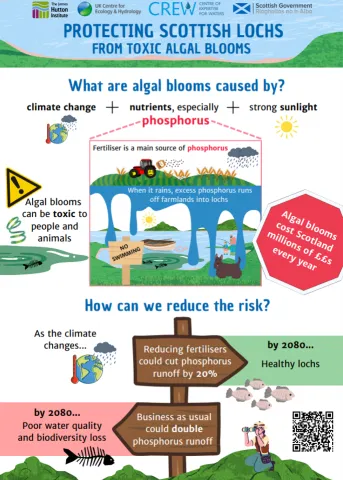
Scotland's lochs have long been cherished for their natural beauty, providing habitats for diverse wildlife and acting as beneficial recreational spaces for locals and tourists alike. However, these iconic water bodies face serious challenges such as climate change and nutrient run-off that threaten their ecological integrity and public health.
Global temperatures are now approximately 1.5ᵒC higher than pre-industrial levels. Rising air and water temperatures, alongside shifting rainfall patterns, are changing our planet’s ecosystem. As such, they pose a threat to the quality of Scottish lochs. Lochs are experiencing an increase in algal blooms due to warmer waters and runoff rich in phosphorus being flushed from the land due to heavy rainfall.
Algal blooms are rapid accumulations of cyanobacteria, also known as blue-green algae, that pose serious risks for the health of both humans and wildlife. Blooms can threaten water security as well as cause habitat degradation, biodiversity loss, and a decline in water quality, jeopardising recreational activities leading to a reduction in amenity value. There are three key elements that, combined, allow the formation of algal blooms: warm temperatures, strong sunlight, and nutrients (especially phosphorus). Reducing any one of these key elements reduces the risk of algal bloom formation.
Phosphorus, a primary constituent of agricultural fertilisers, poses a significant threat as excess amounts seep from the land into lochs during wet weather. Climate change will make this situation more difficult. With climate change, the UK will likely become warmer and wetter in winter and hotter and drier in summer, experiencing more storms and droughts. These projected changes in weather will increase phosphorus concentrations in lochs, thereby increasing the risk of algal blooms developing.
Reducing phosphorus runoff is important and various measures including the installation of buffer strips to intercept runoff and the adoption of sustainable land management practices to minimise fertiliser applications hold promise. Other options, such as, removing nutrient laden sediment and employing chemical treatments to sink algal blooms need careful consideration as these measures are expensive, often need repeating and can be dangerous. Sediment can contain heavy metals and the disruption of algal cells can cause them to rupture, potentially releasing hazardous cyanotoxins into the water.
Phosphorus movement from land to water could more than double by 2080 if agricultural production is intensified causing an 87% increase in average phosphorus concentrations annually. The failure to curb nutrient inputs could be detrimental for Scotland’s lochs, leading them to miss regulatory targets set for high water quality. This is also economically important as the toll of algal blooms is an estimated £16.5 million per year, with far reaching impacts on water treatment costs, property value, tourism and biodiversity. This doesn’t include medical and veterinary costs that could occur as a result of harmful contact with cyanotoxins. Conversely, if sustainable land use practices are adopted more widely and low greenhouse gas emissions are achieved then a 20% reduction in phosphorus runoff may be achieved by 2080, which could improve water quality in around 85% of Scotland’s waters.
Climate change cannot be stopped, but we can adopt proactive measures to protect our lochs from adverse effects. Collaboration among stakeholders, including farmers, landowners, regulators, and policymakers, is crucial to co-create sustainable solutions that safeguard the resilience of our freshwaters. The time for action is now. Combining a low-emissions pathway with targeted measures to reduce phosphorus run-off is a promising strategy to prevent costly algal blooms and preserve the quality of Scottish lochs.